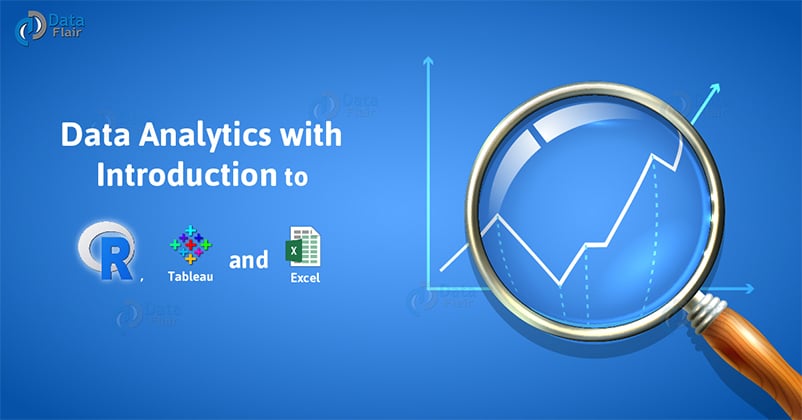Data Analytics with R, Tableau and Excel – Choose the best tool for you!
FREE Online Courses: Transform Your Career – Enroll for Free!
In this tutorial, we will discuss briefly about Data Analytics with R, Tableau, and Excel. We will also study the concept and major features of these tools for a proper understanding.
So, let’s start the tutorial on Data Analytics with Excel, R, and Tableau.
Introduction to Data Analytics with R, Tableau, and Excel
Let’s start our tutorial with discussing about the R programming language
1. What is R?
R is an open source tool. It is used by the Data Scientists for developing statistical software and data analysis. R is a GNU project which is similar to the S language. Hence, we can consider R as an alternative implementation of S.
A C.L.I is a user interface to a computer’s operating system in which the user responds to a visual prompt. Hence, R provides an open source route. One of the most important things of R is that it produces the best publication quality post. This is because R is available as free software under the terms of the Free Software Foundation’s GNU.
R Applications
- Many data analysts and research programmers use R as it is the most prevalent language. Hence, one can use R as a fundamental tool for finance.
- We can use R as a programming tool as it is in use by many quantitative analysts. Depending on the strategy that you might adapt, R provides help for importing data and cleaning it.
- R also provides you with the package ‘Shiny‘ that allows the development of web-applications. You can embed your graphs and plots in these applications.
- R is best for data Science because it gives a broad variety of statistical operations.R provides a robust environment for carrying out statistical computing.Since R stems from S, it can be considered as an alternate form of it.
Explore 370+ Free tutorials on Data Science and ease your path to become a Data Scientist
2. What is Tableau?
According to Fortune, Tableau has “pioneered the concept of visual analytics”.
Technology is evolving rapidly!
Stay updated with DataFlair on WhatsApp!!
Nowadays, Tableau is popular in data science circles. It is an interactive data visualisation company that is based in Seattle. It has released its first public offering in 2013. The basic idea behind the development of Tableau software was to make spreadsheets, charts and dashboards that could be easily interacted by using GUIs.
Clients and Products in Tableau
2.1. Desktop Version
It is used by users to collect data. And on its basis, they perform queries without having to write the code. Further, one can also navigate and visualise the data easily.
2.2. Tableau Server
It is used to access the data by users of the organisation through a browser or mobile.
2.3. Online Version
It is used to call the hosted version of Tableau Server that doesn’t need to be set up.
2.4. Tableau Reader
It is used to publish interactive data online.
It easily lets users access files saved on Tableau Desktop.
3. What is Excel?
- accessibility
- usability
Also, Excel helps in making presentation and reports by integrating it with MS office components. Considering how highly popular the Office suite is, this is an advantage.
- descriptive
- inferential
It provides a standard spreadsheet that you can use for a variety of tasks like updating databases. Excel can also be useful in collating data for analysis using a number of other software.
Excel Features
4. What is Data Analytics?
- Basically, it detects fraud and flaws by keeping a close vigil.
- It helps in refining financial processes by increasing visibility and granting better control.
- Data Analytics reduces risk by being predictive instead of being reactive to the environment.
- It innovates and also creates new models for growth.
- Data Analytics helps in improving IT economics by increasing the agility and flexibility of systems.
- It reduces the cost of managing systems and operations.
- Make quicker, cost-effective decisions.
- Multiple Data Analytics tools like R, SAS or SPSS.
Summary
Did you like this article? If Yes, please give DataFlair 5 Stars on Google



Interested in this course (R+Tableau+Excel)
Yes